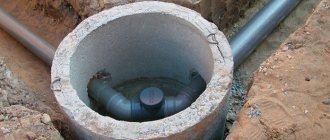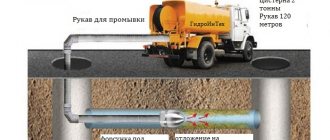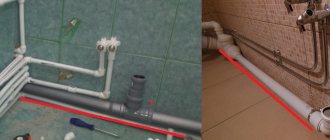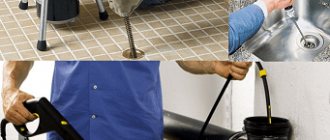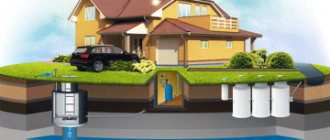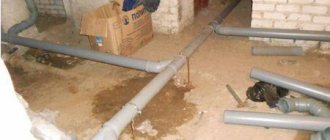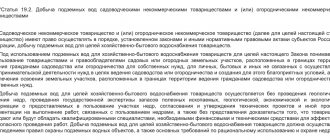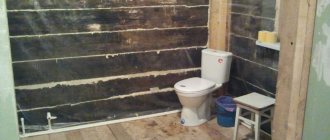What is drainage in utility bills?
The concept of water disposal is clearly defined in Decree of the Government of the Russian Federation dated May 6, 2011 No. 354. It is stated here that drainage is a set of procedures aimed at removing domestic wastewater from residential premises using a connection network. They can be received by all consumers of utility resources.
Regarding the issue of disposal of used water, the state is engaged in legislative regulation and establishes certain rules. Thus, the issue of water disposal is regulated by a number of regulations, including:
- Resolutions of the Government of the Russian Federation, the content of which includes references to housing and communal services;
- regional regulations and provisions on the basis of which the amount payable is calculated;
- local rules of water utilities and other structures related to wastewater disposal;
- resolutions and recommendations coming from local governments.
Is it possible to refuse KPU maintenance or reduce the amount of payments?
Article 30 of the RF Housing Code says that replacing and checking the utility meter is the responsibility of the apartment owner. If the owner of the apartment has not fulfilled it, then in accordance with clause 31 of the Rules for the provision of utility services, approved by Government Decree No. 307 of May 23, 2006, payment for the consumption of utility resources is carried out according to standards or according to a general metering device.
By the way, KPU stands for “apartment metering device.”
But this should not mean that the meter can be checked whenever the management company pleases.
The manufacturer of the measuring instruments has established a service life and only at the end of it do utility workers have the right to check the serviceability of the specified equipment.
Prices for water meters
The cost of a new water meter or water meter is very different. The price range is wide, from several hundred rubles to several thousand. The cheapest one can be bought from 300 -400 rubles.
The price depends on the manufacturer and service life of the device, which is indicated in the passport. It is better to buy from trusted manufacturers so that you do not have to change a device of poor quality.
Unlike electricity meters, water meters are not regulated by accuracy class. The main thing is that it is certified by the State Register of Measuring Instruments of the Gosstandart of the Russian Federation.
How to install individual metering devices, step by step instructions
Step 1. First, you should notify the HOA, housing and communal services or management company of your intention to install an IPU. To do this you will need to submit an application. It is better to fill out the form according to the sample (your management organization will provide it, if necessary), present your passport and title documents for the apartment. A sample is usually provided.
Step 2. Purchase of DHW and cold water meters. As a rule, they are sold complete with everything necessary for its installation. If the kitchen and bathroom have different consumption units, then you need to buy one for each.
Step 3. Installation of metering devices. You can install them yourself, but they must be sealed. To do this, you need to call an accredited organization or a specialist from Vodokanal.
Step 4. Submit instrument readings by the 25th of each month.
Cold water supply and hot water supply in the receipt: what is it
The list of all utility services subject to mandatory payment by consumers is clearly stated in Article 154 of the Housing Code of the Russian Federation. It also states that utility companies have the right to use abbreviations to designate a particular service.
The law states that it is strictly prohibited to change names and their abbreviations, and they must comply with current recommendations. Considering the fact that there are a lot of abbreviations in the receipt, users often have the question of what cold water is.
The abbreviation HVS refers to cold water supply , and the abbreviation DHW refers to hot water supply.
In addition, in payment documents the column may contain the term HVS DPU. It means that payment for consumed cold water occurs on the basis of a common house meter. If the receipt indicates the HVS KPU, this means that the consumer in the apartment has his own metering device, on the basis of which payments are made.
Ways to reduce the payment amount
The fee for such a service can be high. This happens if 3-4 people are registered in the real estate, but only one person lives in it, who does not have metering devices.
Remember: if the real estate does not have meters, and the person is often not at home, then you will have to pay a large sum of money for this service.
Moreover, even if no one lives in the property, they will have to pay for water drainage. It is best to install a meter and pay for utilities using it.
Installing the devices is quite simple.
The user only needs:
- Visit the HOA, housing and communal services, management company, tell about your intention to purchase a water meter. The client must take a passport and property documents. At the office, he must receive a document, fill it out, double-check the information, sign it, and decipher it.
- Buy a water meter. Moreover, you need to purchase not only meters, but also all materials for installation. Remember: you will have to purchase 2 meters. You can also install a meter at each point of consumption. This way the readings will be more accurate. Remember: the shorter the device is in the store, the more accurate information it will show.
- Install water meters. They can be installed independently or through an employee of a company dealing with this issue. Moreover, he must not only install the water meter, but also seal it and check its functionality. After installing it, the user must receive documents that in the future must be submitted to the Criminal Code.
Remember: if the user installs a water meter on his own, he will still need to send documents to the management company, water utility or other companies that will help seal it.
- Request recalculation. The user must notify the management company about the installation of a water meter. Next, he needs to fill out the appropriate form. The recalculated amount is small, but the client will save in the future.
Now he only needs to transfer readings from water meters to the service provider or to the management company every month.
Wastewater disposal in receipt
Many users believe that the name sewerage hides only sewerage, that is, the drainage of used water. However, in fact, the concept itself is much broader, and consists of a mass of procedures, including:
- removal of used hot and cold water;
- transportation of wastewater to treatment facilities;
- purification of wastewater from debris and contaminants;
- liquid waste disposal;
- wastewater disposal (use for technical purposes).
Payment for sewerage in an apartment building: tariff and calculation
The tariff for sewerage is set based on various parameters. Please note that there is no single tariff for Russia, and each region has its own special values. When determining the size of the tariff for payment for sewerage, the following parameters are taken into account:
- climatic and weather conditions of the region;
- current state of sewer networks;
- assessment of the performance of water supply networks;
- distance of pumping water and waste;
- the quality of pumping stations, as well as their remoteness;
- the number of users consuming this service (in particular, those who have a separate meter);
- payment for the services of emergency crews and specialists ensuring the maintenance of networks in acceptable condition. They pay separately for the services that the water supply system requires;
- payment for work of water utility employees.
Depending on the above parameters, there are always significant differences in the size of the tariff scale. So, for example, for residents of Surgut the figure is 25.44 rubles per cubic meter. m, in Rostov-on-Don this value is 24.26 rubles per cubic meter. m, and in Krasnoyarsk the tariff differs the most - 9.42 rubles per cubic meter. m. If the value has increased, the consumer will be notified about this in advance.
To calculate drainage, 3 methods are used:
- Each apartment (private house) has an individual metering device, which is used to determine water consumption.
- Water consumption is determined based on the indicators of common house meters.
- Based on general standards.
Each method has its own characteristics, however, for consumers, the most profitable is the one in which a personal meter is installed in apartments.
Rate
The reason lies in the peculiarities of the waste disposal process and the climate conditions of the region. However, tariffs for these services should be approximately the same.
Most often, the tariff size is determined based on average indicators.
Sometimes the management company may set reduced rates due to the use of a new recycling system that reduces costs.
In some situations, the management company may make mistakes in utility calculations . If they are identified, the consumer of the service must contact the management company employees with a written statement. The form is free, but contains the following information:
- The essence of the problem.
- Personal data.
- Name of the governing body.
- The address of the apartment to which the receipt with incorrect calculations was received.
- Phone number.
The appeal must be registered. It is drawn up in 2 copies, one of which must bear the date of acceptance, the employee’s signature and its transcript.
Cold water supply and wastewater billing center
Issues of water consumption and wastewater disposal are dealt with by a specially formed Center, whose employees calculate tariffs for water disposal, and also monitor the collection of funds.
In 2021, such approved centers exist in every major settlement, and their responsibilities include carrying out any operations related to water consumption and wastewater disposal, in particular, monitoring the current state of networks and sending emergency services to emergency sites. In addition, in case of disputes, the Center will recalculate the payment.
Metering devices for wastewater disposal
In Russia, there are special wastewater metering devices. However, utilities are in no hurry to install them, since the introduction of new equipment is associated with costs.
Still, it’s worth getting acquainted with wastewater meters; they come in several types:
- ultrasonic device,
- electromagnetic counter,
- lever or pendulum device.
The first option is considered the most economical of them. It accurately determines the volume of consumption. However, the cost of such devices is high, so they are not very popular.
An electromagnetic meter is the best option. It collects information well and will help you save on utilities.
The last option is a budget option that is very popular. However, such a counter produces small errors. But you can still save on sewerage costs, since you will only pay for what you consume.
Installing a drainage meter will allow you to save on the cost of utilities, so it’s worth taking advantage of the opportunity presented.
Why is water disposal greater than water consumption?
Users are faced with the fact that the tariff for sewerage can be significantly higher than for water consumption. This is explained by several parameters:
- climatic features of the region. In colder regions, the tariff is traditionally higher, since it is more difficult to maintain network functionality;
- the price for liquid waste disposal is charged at a high level;
- the use of special water purification technologies, the purpose of which is to improve the system.
Consequently, if with regard to water consumption the tariff includes only transportation, preparation for use and heating (for hot water), then in the case of wastewater disposal new operations are added. This means that costs are higher, and therefore the tariff increases.
How to calculate water drainage using a meter: tariff, formula and calculation example
To calculate the payment for sewerage, the following formula :
- SV = (CW + DHW) x TV, where
- SV – amount of payment for sewerage;
- Cold water – the amount of cold water consumed per month (in cubic meters);
- DHW – the amount of hot water used, calculated in cubic meters. m;
- TV – included tariff for wastewater (water) disposal.
The rules for calculating fees for sewerage, as well as recommendations on how to calculate everything correctly, were approved at the highest state level and are spelled out in the Decree of the Government of the Russian Federation “On the procedure and conditions for citizens to pay for housing and utilities.” Let us note an important nuance that the tariff for wastewater disposal is set at the regional level, and therefore, depending on the locality, the value may differ.
As an example of calculation, let's take the city of Krasnoyarsk. The consumer used 20 cubic meters of cold water and 10 cubic meters of hot water per month. The tariff in Krasnoyarsk is 9.42 rubles per 1 cubic meter. m.
Therefore, the consumer will be charged (20 + 10) x 9.42 = 282.6 rubles. Also, to determine the rate, consumers can use a calculator located on special Internet portals.
How is it paid?
Many apartment buildings are serviced by management companies that enter into agreements with water supply and sanitation service providers. Therefore, they calculate the fee for each specific apartment and display the amount on the receipt. Owners of private houses independently enter into contracts with the resource supply organization if the house is connected to centralized water supply and sewerage networks.
Service fees are charged by the management company on a monthly basis. It depends on the amount of water consumed according to the meter or, in the absence of a meter, according to the standard. For the calculation, the volume of cold and hot water is taken. The same number of cubic meters should go into the sewer.
Good to know: How to apply for and calculate a subsidy for housing and communal services?
Calculation examples
In many apartments and private houses, meters for metering consumed resources are already installed. Therefore, the starting point for calculating the consumed water that must be disposed of is the water meter readings.
WATER DISPOSAL = (DHW + cold water) × TARIFF
Since the payment for hot water supply consists of the consumed volume of cold water and its heating, in receipts you can see lines such as:
- cold water supply - the number of cubic meters of cold water according to the meter;
- water heating - only that volume of hot water supply (m3) that is taken from the meter reading (IPU).
Example. At the end of the month, readings were taken from water meters in the apartment of citizen M:
- cold water - 10 cubic meters;
- DHW - 3 cubic meters.
In total, 13 cubic meters of water were consumed, which had to be diverted.
The tariff for these purposes is set at 25 rubles in the receipt: (10 + 3) × 25 = 325 rubles.
You should pay attention to the coincidence of the consumed and allocated volume. If a difference is noticed, you need to contact the management company for clarification as to why this happened.
How to pay for sewerage
Like any other utility services, you must pay a fee per calendar month for sewerage to your apartment . The payment deadlines are quite clear. At the end of the reporting period, a receipt is sent to the consumer, indicating the amount due. Rent must be paid by the 20th day of the month following the reporting month.
Otherwise, defaulters who owe money will be subject to penalties in the form of a fine for each day of late payment. Delaying payment will entail consequences, since the water utility will consider that its interests have been violated.
Possible nuances
The amount of utility bills is affected by several nuances that the management body must keep in mind. For example, a certain category of people has the right to make a payment with a reduced amount. To confirm the right to benefits, citizens must provide relevant documents.
The total amount of all reductions (subsidies or compensation) depends on the category of benefits used by homeowners. It is also influenced by the number of people living in the apartment, as well as the total family income.
The list of established benefits can be found in the territorial division of social protection of the population. Only those citizens who have no debts for housing and communal services can apply for their registration. If they are available, they must be paid in advance before applying for benefits.
ATTENTION! A utility should not offer benefits on its own. They are provided only after presentation of documentation.
All owners whose utility bills exceed 20% of their total income can apply for the benefit.
How to avoid paying for sewerage
Payment for sewerage is mandatory for all citizens living in Russia, and cancellation is not provided. However, on April 16, 2013, the Government of the Russian Federation issued Resolution No. 344, according to which the determination of the standard for wastewater disposal for general house needs is canceled.
Consequently, now the payment for the removal of water for public use should not be included in the receipt (unless otherwise specified in the agreement with the water utility or management company). Otherwise, consumers have the right to file a lawsuit against the violators and demand a recalculation, taking the volume of consumption according to the meter as a basis.
What to do if there is no meter?
The simplest and most economical way to account for water consumption is to use individual meters. But not all residential premises or private households have them installed yet. For such residents, approved consumption standards are applied, according to which calculations and wastewater disposal are carried out. They are enshrined in regulations of local authorities. These standards far exceed the figures that reflect the actual volumes of resource used.
To know how much to put in a receipt for a given resource, the following criteria are taken:
- the number of persons living in this living space;
- average standard water consumption in cubic meters per person;
- tariff established by local authorities for 1 cubic meter of wastewater disposal.
By multiplying all three indicators, you get the amount that will be reflected in the receipt for utilities for this item.
Standards are constantly being revised upward, which encourages the population to install individual meters.
Also read: Is it necessary to install a water meter in 2021?
Deliberate drainage of water
Housing and communal services have the right to demand payment for intentional drainage of water only in a situation where it was made by the owner of the premises, or the noted situation occurred due to leaks and improper condition of the system in the apartment. Note that it is worth draining the water periodically, but the issue of payment remains open.
According to current standards, owners are obliged to monitor the integrity and safety of their property, and if it is determined that the drain occurred due to the owner’s negligence, he will pay. But if the sewage system is new, and everything is in order in the apartment, then the housing and communal services will pay for the intentional drainage.
If there is a deliberate drain of water by housing and communal services employees, consumers will not pay for it. If the payment slip indicates otherwise, that is, there is an unlawful charge of payment, they have the right to contact law enforcement officers with a complaint against the utility companies.
